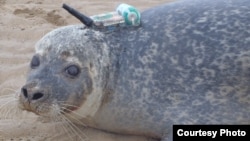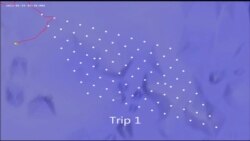Offshore wind farms are harnessing more than wind. Seals are foraging for food at these offshore developments, according to a new study.
Study lead author Deborah Russell, with the University of St. Andrews in Scotland, and her colleagues monitored the location and behavior of 100 seals off the British and Dutch coastlines by tracking GPS tags glued to the animals' backs.
“It is actually quite interesting, the tags transmit that data through the mobile phone system," Russell said. "So they kind of send text messages about where the seals are and where they have been and information about their activity.”
The aim was to better understand the interaction between seals and wind turbines and underwater pipes. The scientists charted grid patterns with the GPS data that show seals visited the structures, sometimes repeatedly. Russell says expected increase in the number of these structures is certain to have consequences.
“The presence of an operational wind farm may make the area less attractive to mammals due to an increase in noise because of operating wind turbines," she said. "However, conversely, they may make the habitat more attractive by increasing prey availability, by decreasing fishing activity or in this case we think it is actually that the anthropogenic [manmade] structures can result in artificial reefs.”
Scientist Deborah Russell explains the tracks of a seal tagged with a GPS chip as it forages for food around off shore wind farms.
The artificial reef could set up a new dynamic in the food chain.
“If the structures increase the overall abundance of prey in the environment, then they may provide the sustainable new foraging opportunities for these biotas [organisms in geographic region]," said Russell. "And in this case the structures should really be designed to maximize these ecological benefits. However, in contrast if the prey, which were previously sparsely distributed, are simply concentrated at these structures, it makes them very vulnerable to be [[vacuumed]] up by marine predators such as seals.”
These are issues that Russell says must be examined in future studies, to better inform decision makers and the public about the best development practices for the mammals and the ocean environment.
The study appears in the latest issue of the journal Current Biology.










